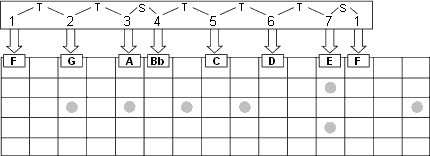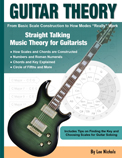Chord Theory
Introduction
A chord, by definition, is when three or more unique notes (unique note names) are played simultaneously. Some will argue that a chord can consist of two or more notes. Rather than get involved with arguing over terminology, we'll just jump straight into some explanations and highlight the important points.
When two notes are played simultaneously we create what is called harmony. This harmonic value is measured by the "distance" or interval between the notes, which, if you like, is just a fancy name for the amount of semitones or half steps any two notes are apart. If you are not exactly sure what that means then think of the frets on a guitar, each fret is equal to one semitone (half step) distance in pitch.
To understand how chords are constructed, you need to first understand the major scale because it's the reference point used to describe note relationships for everything in western music theory. The most important thing to grasp is that the major scale consists of seven notes and the notes are numbered from one to seven. These numbers are relative to each note's scale position and remain constant. In other words the note pitches can change but their relationship, or distance apart will be constant. The diagrams below should clear that up if it's at all confusing.
Note: Different people sometimes use different naming conventions.
A Tone is the same thing as a whole step or whole tone and is commonly abbreviated as T or W
A Semitone is the same thing as a half step or half tone and is commonly abbreviated as S or H.
The major scale always maintains a fixed interval relationship between the notes as follows:
T T S T T T S (or W W H W W W H)
The diagram below shows how this corresponds to the F major scale.

The following diagram shows how the same thing corresponds to the C major scale. Note how the note relationship remains constant, only the notes themselves change. The first note in any scale is the root note. Even though the notes are different, they still maintain a fixed interval relationship in their positions.

Once you are familiar with this numbering convention, you are ready to understand how chords are constructed. We will begin with the most basic of all chords, the Major Triad.
Kindle book available from Amazon
Guitar Theory: Available on Kindle
Learn music theory that's worth knowing
Music theory can be complicated but we need to know it if we want to make sense of everything and improve our guitar knowledge and playing.
My latest book focuses mostly on the things that are really worth knowing, not so much on the rest. Start making sense of chords, scales, modes and finding the key to help you be more creative on the guitar.
Level: Advanced beginner and up.
Author: Lee Nichols Creator of www.guitar-chords.or.uk
(Sponsored Ad)
This website earns advertising commissions. To find out more about cookies, privacy and how we use advertising, please read our Advertising Disclaimer
Contact Info - Cookie and Privacy Policy
Copyright © 2007 - 2024 www.guitar-chords.org.uk


